The iPad Air Review
by Anand Lal Shimpi on October 29, 2013 9:00 PM ESTGPU Performance
Since the iPad Air uses the same A7 silicon as the iPhone 5s, it also uses the same on-die GPU as the 5s: IMG’s PowerVR G6430. This is a 4-cluster configuration of IMG’s latest graphics hardware, running at some relatively high frequency. I already went into some detail on the G6430 in our 5s review so I won’t rehash that here, but we’re basically looking at a shift to a more efficient scalar architecture.
I still don’t have confirmations of clock speeds, but I believe we’re looking at a max GPU clock of around 450MHz. As you’ll see from the results below, there’s a small difference in performance between the iPad Air and iPhone 5s in terms of peak GPU performance - implying very similar clocks. The difference is the iPad Air should be able to sustain its max frequency longer than the iPhone 5s can.
| Mobile SoC GPU Comparison | ||||||||||||
| PowerVR SGX 554MP4 | PowerVR G6430 | PowerVR G6430 | ||||||||||
| Used In | iPad 4 | iPhone 5s | iPad Air | |||||||||
| SIMD Name | USSE2 | USC | USC | |||||||||
| # of SIMDs | 32 | 4 | 4 | |||||||||
| MADs per SIMD | 4 | 32 | 32 | |||||||||
| Total MADs | 128 | 128 | 128 | |||||||||
| GFLOPS @ 300MHz | 76.8 GFLOPS | 76.8 GFLOPS | 76.8 GFLOPS | |||||||||
| GFLOPS as Shipping | 68.1 GFLOPS (?) | 115.2 GFLOPS | 115.2 GFLOPS | |||||||||
Since we’re talking about an A7 here and not an X-series SoC, there’s still only a 64-bit wide memory interface. As memory bandwidth is a key enabler of GPU performance I was curious to see how GPU performance compared to the outgoing iPad 4 with its much wider memory interface. Do keep in mind that the A7 does include a large system cache on-die, which can help improve effective memory bandwidth.
GFXBench 2.7
We'll start our GPU performance analysis with a look at low level results using GFXBench/GLBenchmark 2.7. The low level tests, particularly the offscreen ones, should give us some idea as to whether or not there's any increase in GPU frequency for the iPad Air vs. iPhone 5s implementations of A7.
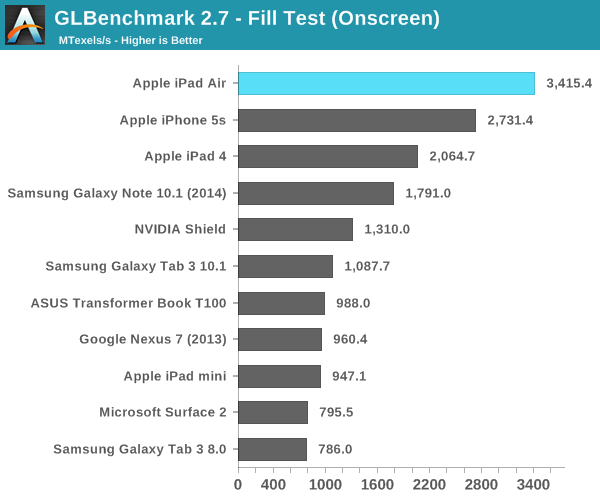
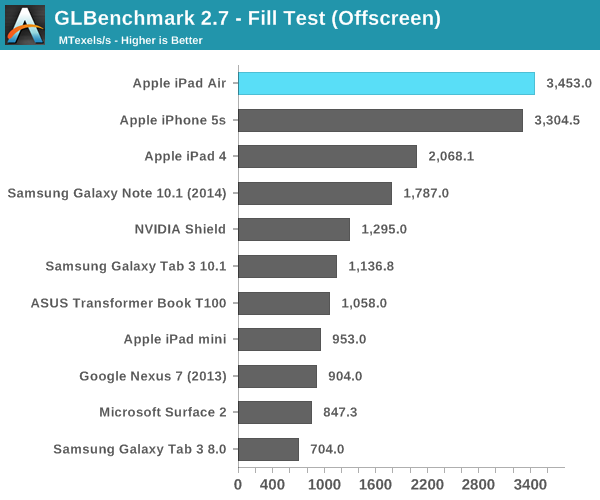
Looking at the fill rate results, there's a 4.5% increase in performance compared to the iPhone 5s. That could be the magnitude of clock increase that we're seeing between A7s. Apple could very well be relying on more thermal headroom in the iPad Air to provide any real world GPU performance advantages over the iPhone 5s.
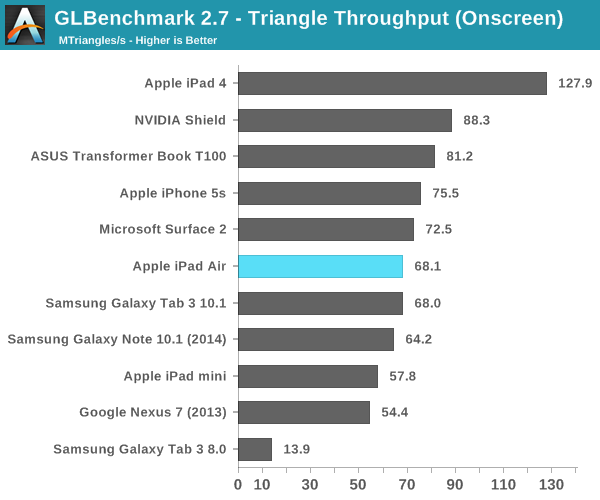

We see an even smaller gap between the Air and 5s in the triangle throughput tests (2.9%). There doesn't seem to be any substantial difference in GPU frequency between A7 implementations here. The regression in triangle rate performance compared to the iPad 4 is explained by differences in how Series 6 and Series 5XT GPUs scale in width. Whereas 5XT replicated nearly the entire GPU for "multi-core" versions, multi-cluster versions of Rogue only replicate at the shader array. The result? We don't see the same sort of peak triangle setup scaling we did back on multi-core 5XT parts. I'm not sure I'm particularly happy with the magnitude of the regression here, but I haven't seen any real world cases where it matters yet.
Next up are the game simulation tests. We'll start with the more strenuous of the two: T-Rex HD.
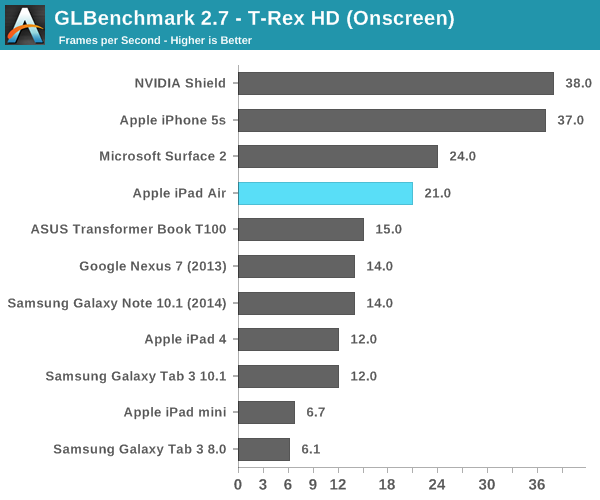
Here we get closer to Apple's claims of a 2x increase in performance. The iPad Air delivers 75% more performance than the iPad 4 in this test. Once again the iPhone 5s pulls ahead but that's because the onscreen tests render at display resolution, which is lower on the 5s.
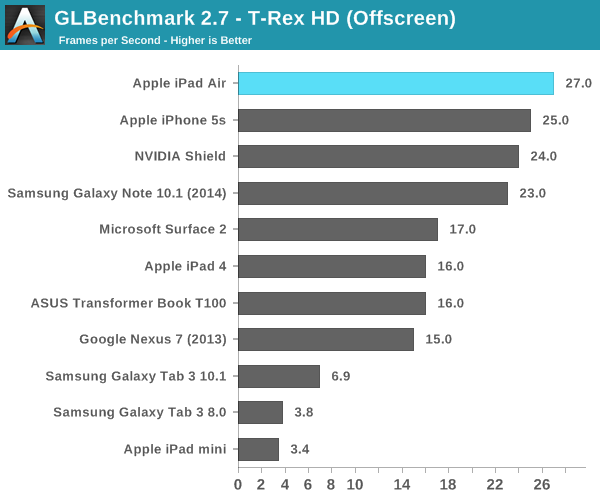
Offscreen performance sees similar scaling: ~69% better performance compared to the iPad 4.
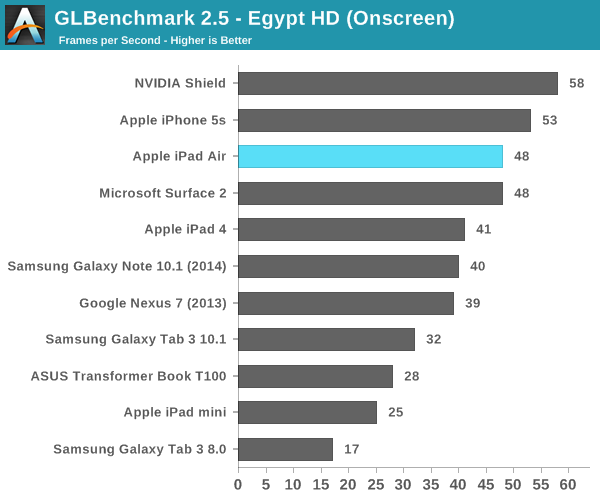
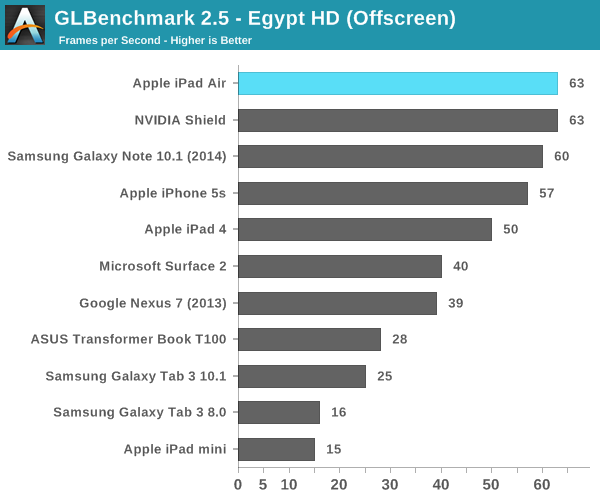
3DMark
We're once again running 3DMark's newest Unlimited mode which does its best to run independently of v-sync and at a standard resolution across all devices. I've also included 3DMark Extreme results below that feature a few more comparison points.
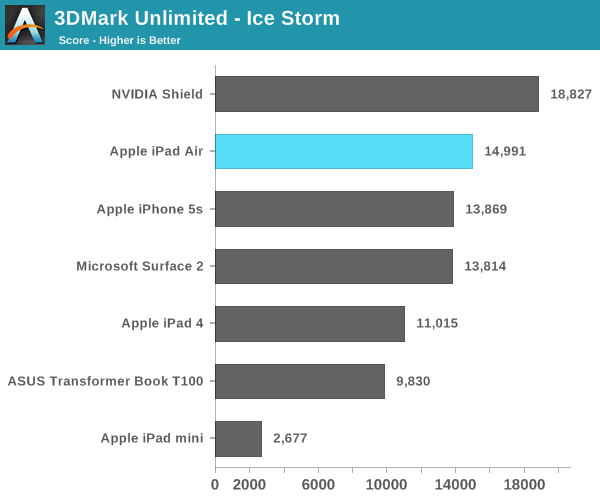
The overall Ice Storm scores show a 36% improvement in performance over the iPad 4 and an 8% increase compared to the iPhone 5s. Given the CPU frequency advantage of the A7 in the Air vs. the iPhone 5s, I'm guessing that's why we're seeing the performance gap we are here.
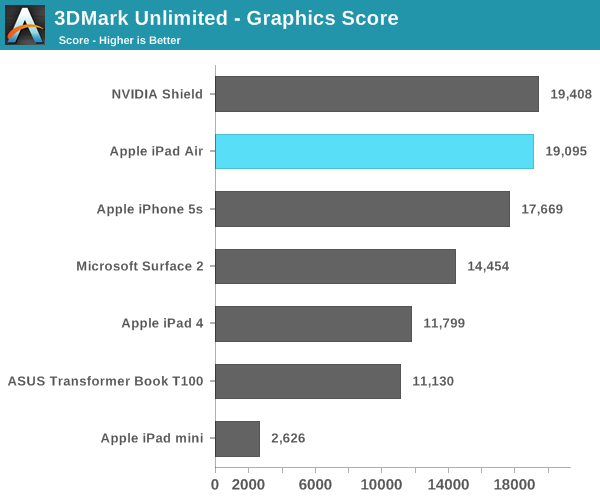
If we focus exclusively on the GPU tests (which themselves are still CPU bound), the iPad Air's performance advantage over the iPad 4 grows to over 60%.
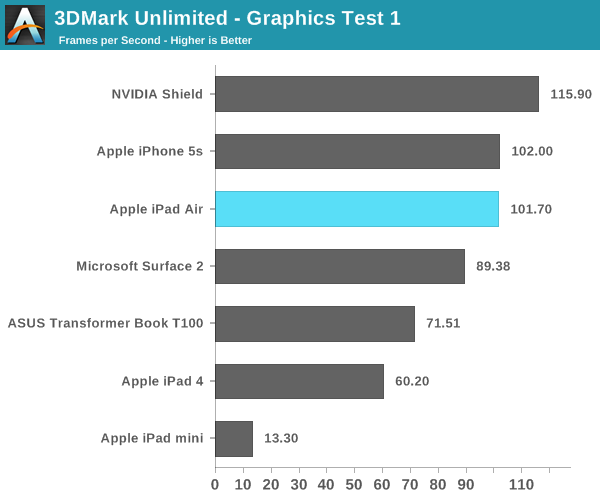
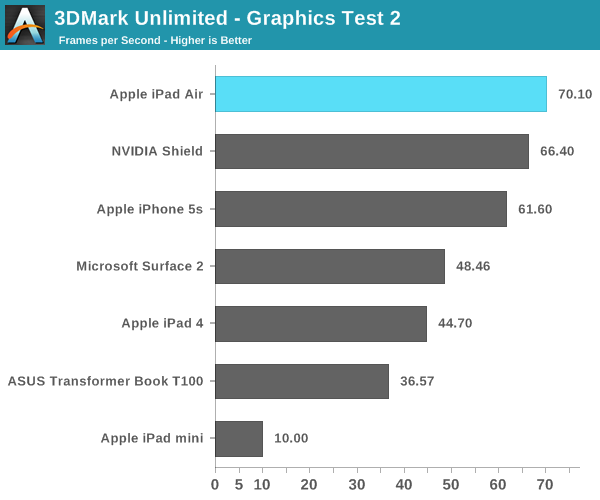
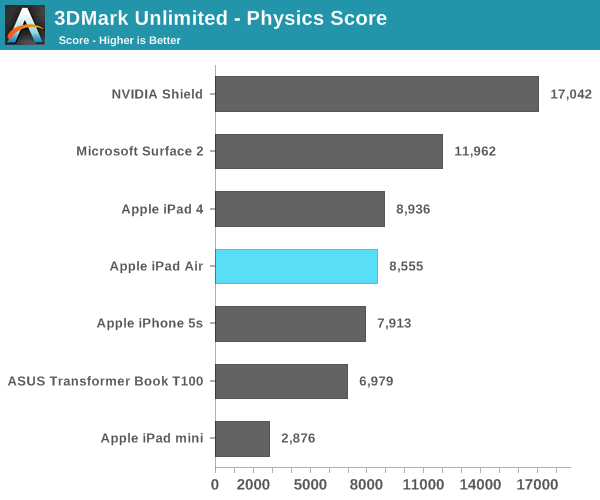
I'm still not entirely sure what's going on with the 3DMark Physics test, but we've seen this two reviews in a row now where Cyclone showed no performance increase at all compared to Swift despite this being largely a CPU test.
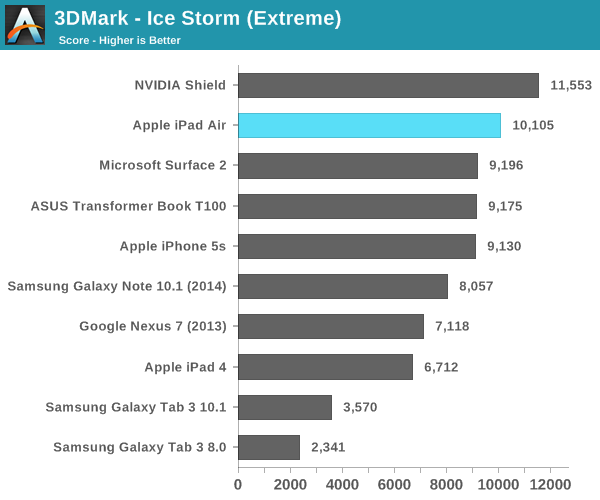
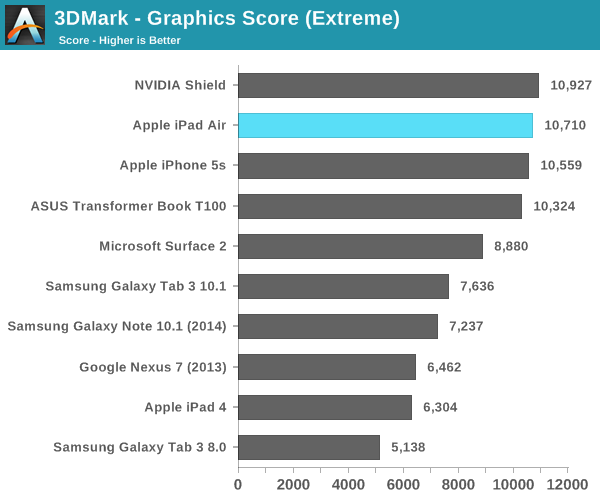
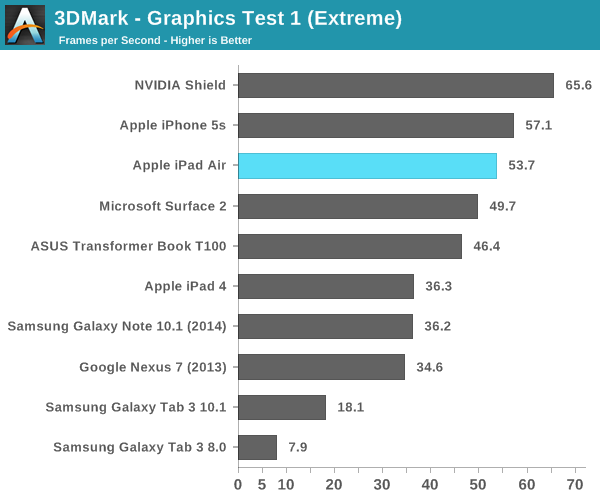
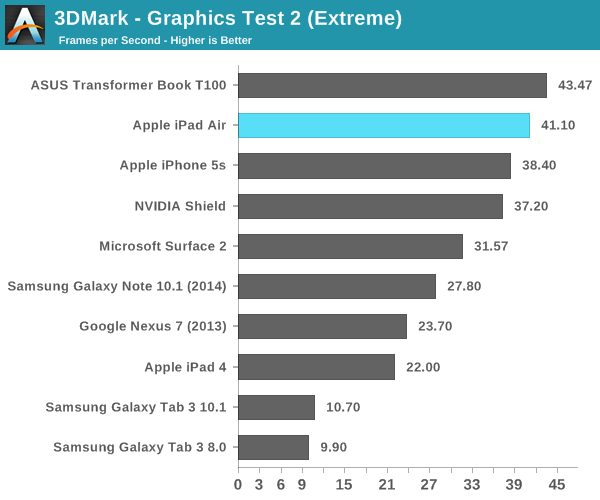

Basemark X
Basemark X is a new addition to our mobile GPU benchmark suite. There are no low level tests here, just some game simulation tests run at both onscreen (device resolution) and offscreen (1080p, no vsync) settings. The scene complexity is far closer to GLBenchmark 2.7 than the new 3DMark Ice Storm benchmark, so frame rates are pretty low.
I'm still having random issues with Basemark X reliably running both on and offscreen tests on iOS 7. Unfortunately I could only get onscreen results for the iPad Air, which came in at 46% faster than the iPad 4. Note the iPad mini and iPhone 5s benefit from having lower native resolutions here, which is why they perform so well.
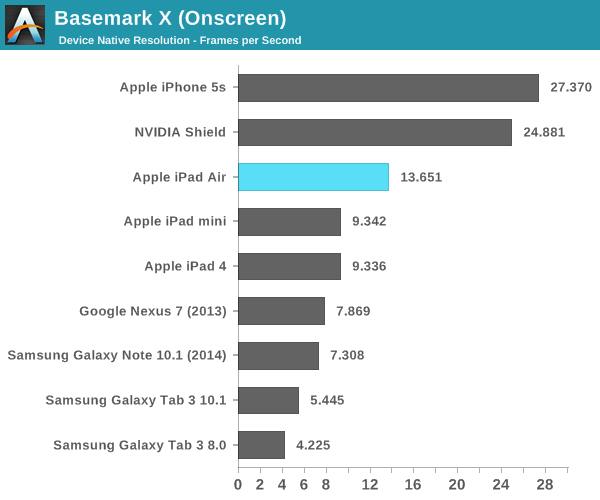










444 Comments
View All Comments
tetsuk - Friday, November 15, 2013 - link
The Macbook Air is great. However, as you mentioned, iWork is not comparable to Office. Since bootcamp works really well, it could still be an option.syedjalalt - Tuesday, November 5, 2013 - link
AnandTech reviews are so unbiased and true unlike The Verge(iSheeps). They go as much deeper as possible to get the best out of their reviews and articles. This is real journalism. Hats off.johned - Tuesday, November 5, 2013 - link
I have a Nexus 4 (soon to be 5) a Nexus 7 first gen and an iPad 2 (soon to be Air). Sometimes I find all the partisan bickering about this stuff hilarious. I like a good row as much as the next guy but I'm a geek. I just love to play with the stuff. I prefer Android to iOS for my daily driver phone, but come on. Anand seems like he's just like me. He loves the tech, all of it, and if had could articulate the way he does, I probably would've started a website like this myself.I will say this, I really don't understand why people think NFC is dead. I use it at least once a day with Google Wallet on my phone. Both major grocery store chains in my area take it. McDonald's takes it. Now, the carrier based service is tanking because they were greedy and botched it. Google wallet I find very useful, though.
Also, I've never had problems transferring files with it. My brother-in-law has a VZW Droid M and I have Nexus devices and I've sent him files from both my tablet and my phone. The most useful thing about it compared to Apple's Air Drop service is that I can do this without needing a wifi connection.
I can honestly say, that the one thing keeping me from an iPhone right now is NFC because I use it so much. If the 5s had included it, I would be sporting one right now. Google Wallet is already available for iOS.
I keep seeing somebody in here sounding like the Apple App Store marketing manager spewing the tired old line about 400blah blah thousand "iPad optimized" apps. This is nice that they are doing that but I observe two things.
1) Google is trying to standardize apps so that 1 app needs to be made for all devices. Since all current Nexus devices have either a 720p or 1080p display, this is easy. This is simply a different approach than Apple is taking.
2)This means that I only need to buy every app 1 time instead of buying it once for my phone and again (usually for a higher price) on my tablet. Apple could mitigate this buy shipping a standard hi-def resolution on the iPhone which they seem reluctant to do.
Back to the original point. We are all geeks here. I appreciate technology. I have opinions about what I like and don't like, but I come to Anandtech because I like to stay current on everything going on. This site also stays largely unpolitical and sticks to the tech, which is why I don't read Ars as much anymore.
JTravers - Wednesday, November 6, 2013 - link
Not sure what you mean about needing a wifi connection for AirDrop. Is having your wifi turned on an issue? AirDrop uses wifi direct, so although you do need to have your wifi turned on you don't need to be connected to a wifi hotspot.nedjinski - Tuesday, November 5, 2013 - link
but wait - there's more -http://www.displaymate.com/Tablet_ShootOut_3.htm
Mayuyu - Wednesday, November 6, 2013 - link
IGZO display instead of IPS. The chart here is wrong.cheshirster - Wednesday, November 6, 2013 - link
Windows tablets are going to suppress ipads sales in coming months.Still no mention in conclusion. That's hilarious, at some point.
AngryCorgi - Thursday, November 14, 2013 - link
Again, you are listing the #s for GFLOPS/core, not the total GPU GFLOPS on the Rogue chips. You need to clarify that. And the older 554MP4 was 21.6 GFLOPS @ 300MHz (14.4 GFLOPS @ 200MHz, as ID'd by Imagination Tech).Atlink - Saturday, November 30, 2013 - link
I'm truly not trying to stir the pot at all, but I am curious about NFC. I understand what it is, and its possible application, however, I'm not seeing anyone really clamor for it. This whole NFC deal seems like the HD-DVD/Blu-Ray war all over again. Neither side really had a lead until Sony began to tip the scales in their favor due to the PS3's exclusive use of Blu-Ray discs for games.I understand that NFC can be used to do some neat things: pay for food, verify a subway ticket, check into a hotel, etc. The problem that I'm seeing is one that anyone without a NFC phone can see: the lack of NFC-enabled terminals. I would say that Apple is dropping the ball something fierce if there were NFC terminals to scan this and that almost everywhere, but like QR codes, they seem almost like a novelty. I *could* scan that code with my phone by either downloading an application that can do it, and then hoping that the code can be read by the program, and hoping that the URL is worth looking at... or I could just type in the URL right below it (yes, I know not everything has a short URL below it). I *could* use NFC by sitting down with my credit cards in advance, creating an account, punching in the numbers, verifying data, opening the app when needed, sorting through the cards I plan to use, selecting the correct one, ensuring the transaction was accepted by the POS... or I could just use my debit card like I have been doing for years now, swipe once, punch in my PIN, and be done with it.
Like I said, I do think that NFC is a really neat idea, and I would love the saturation to become more prevalent in the US, but as of now, it's kind of a neat idea with no real, practical application. I guess the problem I'm having is trying to understand the importance of having it NOW. Some people use NFC as a selling point, and that just seems odd.
I think that when NFC catches on, and you begin seeing it almost everywhere, then we'll start seeing it in Apple products. No point in putting something in if you aren't going to be able to use it, right?
divps - Saturday, November 30, 2013 - link
I have a Nexus 7 and use an iPhone 5. We also have the iPads, a Nexus 4, a Nexus 5 and a Galaxy Nexus phones in the household. I use the Nexus 7 as my tablet for the things that it is strong at and use the nice iOS ecosystem for Apps that I need and that's generally good enough for me. I like the idea of wireless charging and I'm going to get a wireless charger for the Nexus 4 and Nexus 5. The Micro-USB connector isn't the easiest thing to connect without a little effort and the connector can get fatigued over time. It's also nice if you can just come home and put the phone on the platform and pick it up when you need it. The Apple connector is a lot easier for me to put in but wireless charging would mean that I wouldn't need as many lightning cables at home.The Apple ecosystem is generally smoother and nicer. I recently upgraded my Nexus 7 to KitKat and it ran like a dog and I tried a bunch of things and eventually had to do a factory reset which means that I lost a bunch of things and had to re-add them. There are several threads on this on the Phandroid Nexus 7 forums. The iOS 7 upgrade was a piece of cake compared to the KitKat upgrade. I also found UI differences for some simple things between the Nexus 5 and Nexus 7 on KitKat. On the Nexus 7, you do left and right pulldown for notifications and settings. On the Nexus 7, you do one-finger and two-finger pulldowns for notifications and settings. I had thought that the UIs would be the same but I guess not.
I'm extremely impressed with the Nexus 5 hardware - it's very, very fast, great screen, very thin, good feel in hand. I don't like the layout of the volume control and it has known problems with shutter lag and audio output (which I hope will be fixed with software). It's an incredible value for the money.
The thing that I like about Android is the ease of copying content over to them. You just plug them into a PC and drag and drop your files and the Apps will find them on the device. With iOS, I have to convert videos to MP4, or documents to an iBooks compatible format.
I think that the music player and email apps on iOS are far better than the OS provided ones on Android. Google should have done a better job copying iOS Apps there.